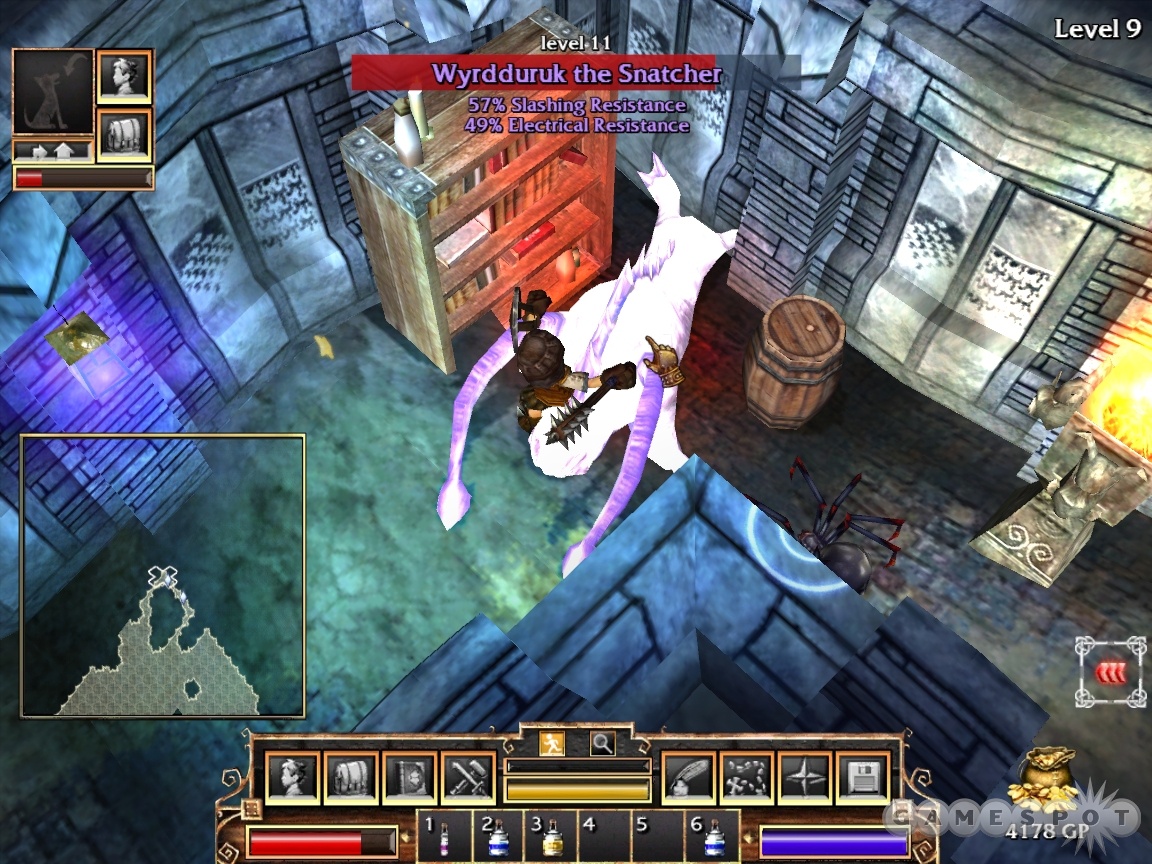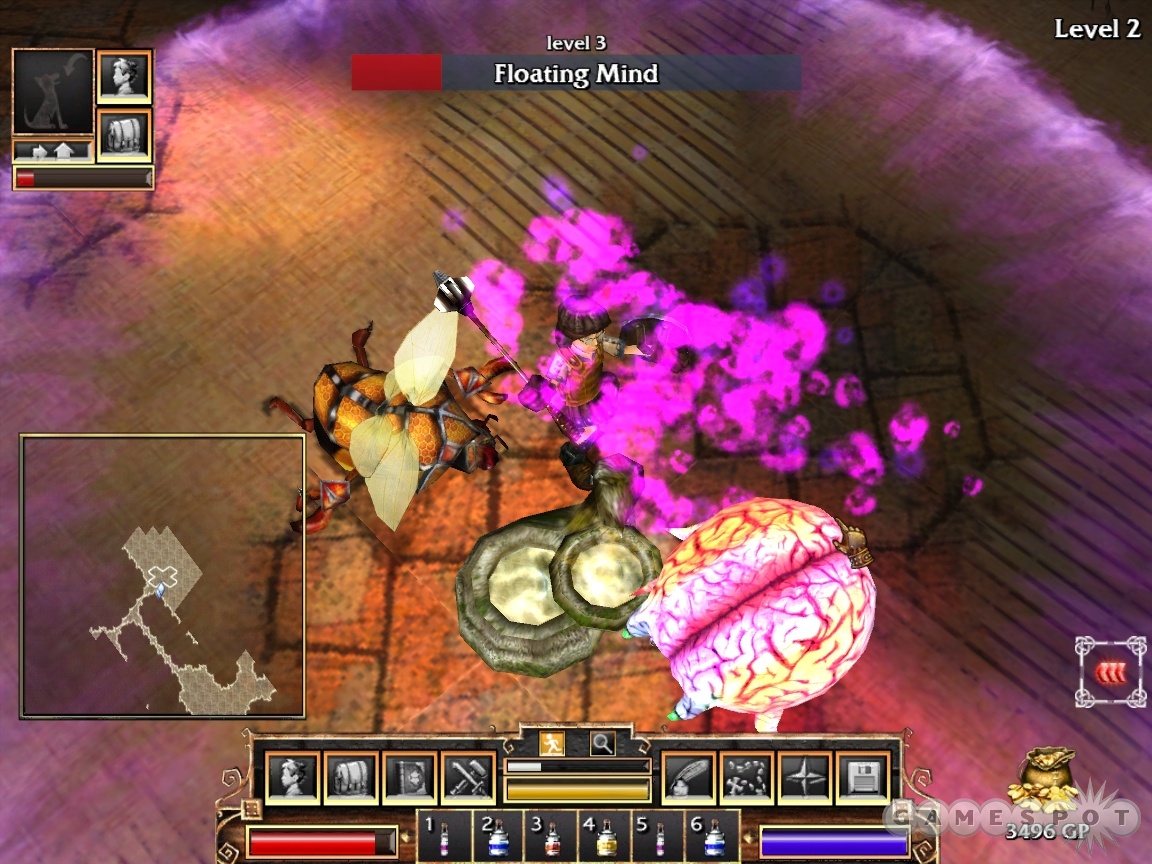Fate: Undiscovered Realms adds a pair of new levels, a dead-is-dead option, and pretty much nothing else to the original Fate. So expect this hack-and-slash role-playing stand-alone add-on to provide you with a good dose of deja vu if you have any experience with the previous game released back in early 2005. The simple charm of the core game design still looms large over this Diablo clone, however, which gives its clickfest dungeon crawling the power to suck you in for many, many hours.
Undiscovered Realms is a continuation of the single-player story from the original Fate (there's still no multiplayer). After a long campaign against the forces of evil, your hero returns to the town of Grove. Forget about any celebrations with beautiful elf maidens and grog, though. A mysterious stranger soon arrives and cons you into opening portals into two new realms, a wooded world called Druantia and an icy kingdom named Typhon. The cowled weirdo then reveals himself as some kind of evil wizard and takes off, leaving you to head through these gates as well to stop his dastardly machinations.

Character design covers the same old ground. Development is exactly as it was in the first Fate. There are no set character classes, so you craft your hero by assigning points to traits like strength and dexterity and to skills such as swords and magic every time you gain enough experience to level up. It's a smooth, elegant system that lets you effortlessly build a fighter, a mage, or a jack-of-all-trades. Items are largely carried over from the original game. Monster drops feature a lot of the same swords, axes, and armor as before--albeit with the addition of some special items, such as the swathe quest gear--and the character spell list is identical. A pet dog or cat companion that levels up automatically is still at your side helping to battle the monstrous hordes, although now there are more transformation options available every time you feed Fido or Trixie one of the game's magical fish. It's kind of hard to tell what's new, since you could already morph your pooch or feline into a wide selection of giant spiders, unicorns, wyverns, and more.
Revival options after your character is killed remain unforgiving, with Fate himself appearing to extort gold, experience points, and/or hero renown to resurrect you. Even then, the options often aren't good. The most affordable choices tend to get you ported to a level that's a flight or two down from your earlier position or a few levels up without any of your gold. A new hardcore mode of play makes things even more challenging. On this setting, when you're dead, you're dead. Don't even think about checking it out unless you're a serious Fate veteran, because it's murderously tough.
Not a lot of imagination went into setting up your adventures into these new lands, but they get the job done. Game structure here is also pretty similar to the original Fate and is based around hubs leading to towns and the dungeons. Your hero (either a brand-new one or an import of your character from the first game) starts off in the Temple of Fate hub, which features gates to Druantia and Typhon. From there, you choose a town to enter and wind up in a secondary hub populated by a motley crew of monsters who assign quests, sell goods, heal injuries, enchant items, and so forth. Once you do business here, you head off down the nearby steps to slay monsters and solve problems in pretty much limitless randomized dungeon levels.
Quests are mostly basic stuff. You get sent down to a dungeon level and must complete tasks such as destroying an evil shrine, protecting a good shrine, killing a boss, locating a magical artifact, or escorting a monster. As usual with hackfest RPGs, objectives don't seem to matter much. You spend almost all of your time click-slaying packs of attacking monsters, so saving a shrine on dungeon level two doesn't feel much different from killing a big minotaur on dungeon level 14. Monster types seem more repetitive here than in the original Fate, which is in keeping with the simple, recycled forest and ice backgrounds of the two new dungeons. Many of the new types pop up over and over again across multiple dungeon levels. Some are extremely weird, at least. Druantia is loaded with oddities like the death-cap walking mushroom and the big-brain floating mind, while Typhon is stocked with creeps like the crystal crab and the dire walrus.

Unbalanced difficulty is a bigger problem than repetition, though. While the challenge does steadily ramp up with each dungeon level you go down, you frequently get tossed into situations that are virtually impossible to deal with at your current level. This hits you right off the bat. In level two of Typhon, for instance, you're faced with the impossible task of destroying an evil shrine protected by a horde of zombies and rats and a magic weapon that can kill you with a single shot. The only way to deal with this job is to skip it and venture deeper into the dungeon. A lot of experience points, artifacts, and gold are needed to properly take on this assignment, so forget about handling it early in the game. Of course, going deeper can be a hassle since you occasionally run into monsters with the ability to steamroll your hero. One moment you're cruising along taking out frost orcs and broadwings, and the next you're getting smashed into a fine red powder by a minotaur. Since you can never predict what sort of opposition you're going to face, you can easily wind up in a fight you're unprepared for and get killed out of the blue. And because of the game's harsh hero revival options, you can then find yourself stuck far below the surface in hostile territory, getting killed over and over again until you luck out and manage to run for the stairs leading up.
Though Fate: Undiscovered Realms is an add-on that is more about extending the original game than expanding it, the fundamentals are strong enough to make it appealing. This is an addictive hack-and-slash RPG, even if it isn't a very creative one.



